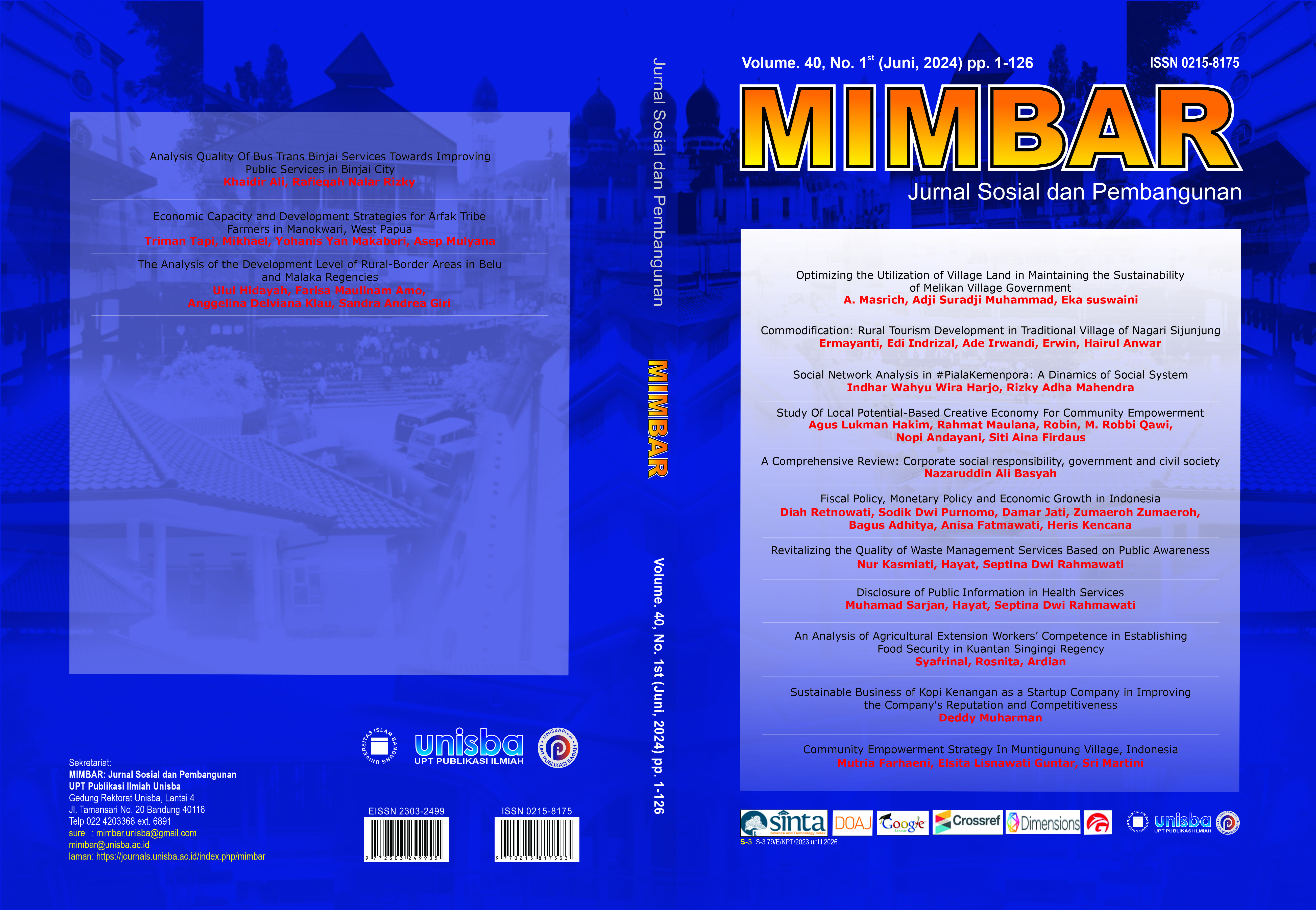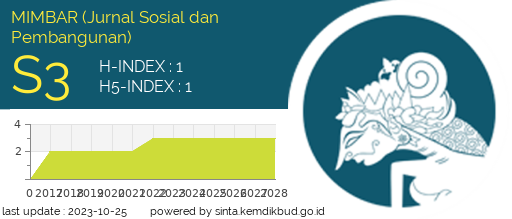Fiscal Policy, Monetary Policy and Economic Growth in Indonesia
DOI:
https://doi.org/10.29313/mimbar.vi.3424Keywords:
Fiscal Policy, Monetary Policy, Economic GrowthAbstract
Economic growth is still a measure of the success of policies made by the government. Indonesia, a developing country, needs the right policies to continue to encourage economic growth and rise from the crisis that has occurred. The economic crisis that occurred in 1998, 2008 and 2020 requires Indonesia to have the right fiscal and monetary policies to recover quickly. This study aims to analyze the effect of the impact of fiscal policy (taxes and government expenditure) and monetary policy (money supply, inflation, and exchange rate) on economic growth in Indonesia. The method used in this study is multiple linear regression with time series data from 1990 to 2020. The results of this study prove that tax revenue has a positive effect on economic growth in Indonesia. Meanwhile, government spending, inflation, money supply and exchange rates have a negative effect on economic growth in Indonesia. The implications of this study show that both monetary policy and fiscal policy should be made through in-depth study. The government must be able to increase tax revenue and spend state revenues on investment needs. Monetary policy must also be able to maintain low inflation and strengthen the exchange rate through trade and foreign exchange reserves.
References
Afanasyeva, O. (2021). Money supply as an instrument of monetary policy and the promotion of economic growth. Finance and Credit. https://doi.org/10.24891/fc.27.7.1540.
Aristina, K., Julprijanto, W., & Prasetyanto, P. (2020). Analisis Kebijakan Moneter dan Kebijakan Fiskal Terhadap Pertumbuhan Ekonomi di Indoneisa tahun 2005-2018. Dinamic :Directory Journal Of Economic, 2(2).
Asnawi, & Fitria, H. (2018). Pengaruh Jumlah Uang Beredar, Tingkat Suku Bunga dan Inflasi Terhadap Pertumbuhan Ekonomi Di Indonesia. Jurnal Ekonomika Indonesia, 7(01), 7.
Asian Development Bank. (2022). Indonesia’s Economic Growth to Strengthen in 2022, 2023. https://www.adb.org/news/indonesia-economic-growth-strengthen-2022-2023-adb Diakses pada 24 Agustus 2022.
Bahtiar, R. & Saragih, J. (2019). Upaya Meningkatkan Penerimaan Pajak Dan Meminimalkan Shortfall Pajak. Jurnal Bidang Ekonomi Dan Kebijakan Publik, 11(24), 21.
Butkiewicz, J., & Yanīkkaya, H. (2011). Institutions and the Impact of Government Spending on Growth. Journal of Applied Economics, 14, 319 – 341. https://doi.org/10.1016/S1514-0326(11)60017-2.
Connolly, M., & Li, C. (2016). Government spending and economic growth in the OECD countries. Journal of Economic Policy Reform, 19, 386 – 395. https://doi.org/10.1080/17487870.2016.1213168.
Dang, T. T., Dang, H., & Liên, N. (2022). Effects of Monetary Policy and Government Effectiveness on Economic Growth: Evidence from 49 Countries Worldwide. Journal of Hunan University Natural Sciences, 49(8). https://doi.org/10.55463/issn.1674-2974.49.8.6.
Demir, F., & Razmi, A. (2022). The Real Exchange Rate And Development Theory, Evidence, Issues And Challenges. Journal of Economic Surveys, 36(2), 386–428. https://doi.org/10.1111/JOES.12418.
Ghozali, I. (2018). Aplikasi dan Analisis Multivariate Dengan Program IBM SPSS 25 Edisi 9. Badan Penerbit Undip.
Ginting, A. M. (2017). Analisis pengaruh ekspor terhadap pertumbuhan ekonomi Indonesia. Buletin Ilmiah Litbang Perdagangan, 11(1), 1–20. https://doi.org/10.30908/bilp.v11i1.185
Indiarti, M. (2018). Pengaruh inflasi, suku bunga Bank Indonesia (BI) dan nilai tukar Rupiah/US $ terhadap perekonomian Indonesia. Jurnal Manajemen Kewirausahaan, 15(2), 193.
Indriyani, S. (2016). Analisis Pengaruh Inflasi Dan Suku Bunga Terhadap Pertumbuhan Ekonomi Di Indonesia Tahun 2005-2015. Jurnal Manajemen Bisnis Krisnadwipayana, 4(2), 9.
Jaya, I. Manik, G. S., & Kartika, I. N. (2019). Pengaruh Kurs USD Dan Tingkat Inflasi Terhadap Nilai Ekspor Rokok Kretek Serta Pertumbuhan Ekonomi Indonesia. E-Jurnal Ekonomi Pembangunan Universitas Udayana, 8(10), 25.
Karmeli, E., & Fatimah, S. (2008). Krisis Ekonomi Indonesia. Journal Of Indonesian Applied Economics, 2(2), 164.
Kistianingsih, D. (2019). Analisis Pengaruh Jumlah Uang Beredar, Inflasi,Investasi dan Nilai Tukar Rupiah Terhadap Pertumbuhan Ekonomi Di Indonesia Tahun 2000-2017. Universitas Muhammadiyah Surakarta.
Kusumatrisna, A. L., Sugema, I., & Pasaribu, S. H. (2019). Efek Threshold Inflasi Terhadap Pertumbuhan Ekonomi Regional Di Indonesia. Jurnal Ekonomi Dan Pembangunan, 27(1), 51. DOI: https://doi.org/10.14203/JEP.27.1.2019.43-52
Lunjun, Z. (2005). Tax vs. Economic Growth in 2004. Finance & Trade Economics.
Mankiw, N. (2007). Makroekonomi. In Edisi enam. Erlangga.
Mutia, K. A., Indrawati, L. R., & Sarifah, S. N. (2019). Pengaruh Pengeluaran Pemerintah Dan Jumlah Uang Berdasar Terhadap Produk Domestik Bruto Indonesia Tahun 2004 – 2018. Directory Jurnal Of Economic, 1(1), 114–126.
Natasya, N., & Nasir, M. (2022). Does the Tax Structure Play a Role in Economic Growth? Empirical Evidence from Indonesia. MIMBAR: Jurnal Sosial Dan Pembangunan, 250–256.
Nopirin. (2018). Ekonomi Moneter. Edisi Keempat. BPFE. Yogyakarata.
Nurlina. (2015). The Effect Of Government Expenditures On Indonesia Economic Growth. Journal Of Economics, Business, and Accountancy Ventura, 18(1), 12.
Nurlina & Zurjani. (2018). Dampak Kebijakan Fiskal dan Moneter dalam Perekonomian Indonesia. Jurnal Samudra Ekonomika, 2(2), 10.
Pridayanti, A. (2014). Pengaruh Ekspor, Impor Dan Nilai Tukar Terhadap Pertumbuhan Ekonomi Di Indonesia Periode 2002-2012. Jurnal Mahasiswa Universitas Negeri Surabaya, 2(2), 5.
Prihatin W, Arintoko, & Suharno. (2019). Analisis Pengaruh Variabel-variabel Moneter Terhadap Pertumbuhan Ekonomi Indonesia. Jurnal Ekonomi, Bisnis Dan Akuntansi (JEBA, 21(03), 1–2.
Razmi, A., Rapetti, M., & Skott, P. (2012). The real exchange rate and economic development. Structural Change and Economic Dynamics, 23, 151–169. https://doi.org/10.1016/J.STRUECO.2012.01.002.
Ribeiro, R., Mccombie, J., & Lima, G. (2020). Does real exchange rate undervaluation really promote economic growth? Structural Change and Economic Dynamics, 52, 408–417. https://doi.org/10.1016/J.STRUECO.2019.02.005.
Rinaldi, M. Jamal, A., & Seftarita, C. (2017). Analisis Pengaruh Perdagangan International dan Variabel Makro Ekonomi Terhadap Pertumbuhan Ekonomi Indonesia. Jurnal Ekonomi Dan Kebijakan Publik Indonesia, 4(1), 50.
Safari, M. (2016). Analisis Pengaruh Ekspor, Pembentukan Modal, Dan Pengeluaran Pemrintah Terhadap Pertumbuhan Ekonomi Indonesia. Skripsi Universitas Negeri Yogyakarta.
Sanjaya, I., & Anis, A. (2021). Analisis Kuasalitas Penerimaan Pajak, Pengeluaran Pemerintah Dan Pertumbuhan Ekonomi Di Indonesia. Jurnal Kajian Ekonomi Dan Pembangunan, 3(4), 3.
Saragih, A. (2018). Pengaruh Penerimaan Pajak Terhadap Pertumbuhan Ekonomi Di Indonesia. Jurnal SIKAP, 3(1), 26.
Sari, M., Syechalad, M. N., & Majid, S. A. (2016). Pengaruh Investasi, Tenaga Kerja Dan Pengeluaran Pemerintah Terhadap Pertumbuhan Ekonomi Di Indonesia. Jurnal Ekonomi Dan Kebijikan Publik, 3(2).
Satria, D. (2012). Hubungan Inflasi Dan Pertumbuhan Ekonomi Di Indonesia. Jurnal Ecosains Universitas Negeri Padang, 1(2), 6.
Seftarita, C., & Suriani, S. (2022). The Effectiveness of Monetary Policy and the Effect of Global Economic Shock on Net Financial Accounts in Indonesia. MIMBAR: Jurnal Sosial Dan Pembangunan, 26–33.
Selfiana, S., Laut, L. T., & Destiningsih, L. R. (2020). Pengaruh Perdagangan International, Pengeluaran PemerintahDan Pengeluaran Rumah Tangga Terhadap Pertumbuhan Ekonomi Di Indonesia Tahun 1989-2018. Directory Journal Of Economic, 2(4), 1014. DOI: 10.31002/dinamic.v2i4.1441
Simanungkalit, E. (2020). Pengaruh Inflasi Terhadap Pertumbuhan Ekonomi Indonesia. Journal Of Management, 13(3), 338.
Sitanggang, E., Aulia, J., Matondang, K., & Indriani, R. (2022). The Effect of Inflation on the Rate of Economic Growth. Asian Journal of Applied Business and Management. https://doi.org/10.55927/ajabm.v1i1.1725.
Smith, C. (2004). The long-run effects of monetary policy on output growth. Reserve Bank of New Zealand Bulletin, 67, 6.
Stockman, A. C. (1981). Anticipated inflation and the capital stock in a cash in-advance economy. Journal of Monetary Economics, 8(3), 387–393.
Suhendra, I. (2020). Nilai Tukar, Keterbukaan Ekonomi dan Kinerja Pertumbuhan Ekonomi Di Indonesia. Jurnal Riset Bisnis Dan Majemen Tirayasa (JRBMT (Vol. 4, Issue 1, p. 89).
Suhendra, I., & Irawati, D. A. (2016). Pengaruh Tabungan, Pengeluaran Pemerintah Dan Investasi Swasta Terhadap Produk Domestik Bruto di Indonesia. Jurnal Ilmu Ekonomi, 6(2). DOI: http://dx.doi.org/10.35448/jequ.v6i2.4346
Septiawan, D. A., Hidayat, R. R., & Sulasmiyati, S. (2016). Pengaruh Harga Minyak Dunia, Inflasi, Dan Nilai Tukar Terhadap Pertumbuhan Ekonomi Indonesia (Studi Pada Tahun 2007-2014. Jurnal Admisitrasi Bisnis (JAB, 40(2), 136.
Sulaini, N., & Pratomo, W. S., & N. (2014). Efektifitas Sistem Nilai Tukar Mengambang Bebas Dalam Inflation Targeting Framework Di Indonesia. Jurnal Ekonomi Dan Keuangan, 2(4), 209.
Susandiana. (2016). Dampak Kebijakan Moneter Terhadap Pertumbuhan Ekonomi Di Indonesia Tahun 1999-2014. Naskah Publikasi Universitas Muhammadiyah Surakarta.
Susanto. (2017). Pengaruh Inflasi, Tingkat Suku Bunga dan Nilai Tukar Terhadap Pertumbuhan Ekonomi Indonesia. Jurnal Ekonomi Bisnis Indonesia, 12(01), 3.
Syamsuyar, H., & Ikhsan, I. (2017). Dampak Sistem Nilai Tukar Terhadap Pertumbuhan Ekonomi Indonesia. Jurnal Ilmiah Mahasiswa (JIM, 2(3), 417.
Tiwa, F. R., Rumate, V., & Tenda, A. (2016). Pengaruh Investasi, Suku Bunga Sertifikat Bank Indonesia (SBI) Dan Jumlah Uang Beredar Terhadap Pertumbuhan Ekonomi Indonesia Tahun 2005-2014. Jurnal Berkala Ilmiah Efisiensi, 16(2), 345.
Wahyuni, T. (2021). Pengendalian Inflasi, Moneter, Dan Fiskal Dalam Perspektif Ekonomi Makro Islam. Ekonomica Sharia:Jurnal Pemikiran Dan Pengembangan Ekonomi Syariah, 6(2), 199–210.
Wanda, H. K., & Kartika, I. N. (2021). Pengaruh Kurs, Tingkat Inflasi Dan Nilai Ekspor Karet Terhadap Pertumbuhan Ekonomi Indonesia Tahun 2000-2017. E-Jurnal Ekonomi Pembangunan Universitas Udayana, 10(7), 29–46.
Widmalm, F. (2001). Tax Structure and Growth: Are Some Taxes Better Than Others? Public Choice, 107, 199–219. https://doi.org/10.1023/A:1010340017288.
World Data Info. (2022). Development of Inflation Rate in Indonesia. https://doi.org/https://www.worlddata.info/asia/indonesia/inflationrates.php#:~:text=The%20inflation%20rate%20for%20consumer,the%20price%20increase%20was%2078%2C664%2C025.83%20%25. Diakses pada 22 Agustus 2022.
Wu, S., Tang, J., & Lin, E. (2010). The impact of government expenditure on economic growth: How sensitive to the level of development? Journal of Policy Modeling, 32, 804–817. https://doi.org/10.1016/J.JPOLMOD.2010.05.011.
Yazid, M. (2019). Pengaruh Inflasi, Kurs, Dan Suku Bunga Terhadap Pertumbuhan Ekonomi. Jurnal Ekombis, 5(1), 44.
Downloads
Published
Issue
Section
License
Copyright (c) 2024 Diah Retnowati, Sodik Dwi Purnomo, Damar Jati, Zumaeroh Zumaeroh, Bagus Adhitya, Anisa Fatmawati , Heris Kencana

This work is licensed under a Creative Commons Attribution-NonCommercial-ShareAlike 4.0 International License.














